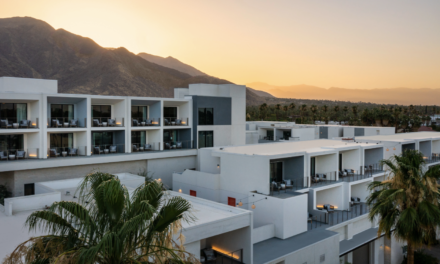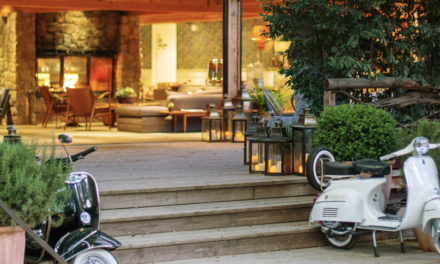
Rooftop Views of Morro Rock, Bay and Harbor at Ascot Suites

Recently we discovered a hidden gem along the central coast, Morro Bay. We have driven by the waterfront town that touts a “Come Get Salty” slogan, but have never stopped for an overnight stay.
Known as the “Gibraltar of the Pacific,” Morro Rock is the nesting area for snowy plovers, and a protected reserve for the endangered peregrine falcon. Morro Bay is home to sea lions and sea otters. Hermit crabs and starfish can be seen within the rocky crags and on the beach. All the fauna on and around Morro Rock is protected by the state of California.

Picturesque Morro Bay. Photo by Jill Weinlein
Escaping the heat down south, we drove up to Morro Bay for an overnight stay at Ascot Suites. Heading off scenic Highway 1, we checked into the renovated black and white boutique hotel. Guest rooms are clean, spacious and have a fireplace and balcony to step out onto to take in the views of Morro Rock and the bay.

Ascot Suites. Photo Jill Weinlein
Though not directly on the waterfront, Ascot Suites is located in the center of town just two blocks and a stairway away for Embarcadero. The new rooftop lounge is an ideal place to sip coffee in the morning, and to enjoy a glass of wine at sunset. Guests can purchase a bottle of wine in the lobby to take up to the rooftop. In the evening guests can gather around the fire pit in the comfortable lounge area for stargazing.

Room with a view. Photo Jill Weinlein
The hotel offers guests a complimentary hot and cold breakfast in the morning of the lobby. There is a small dining area, or guests can bring their items up to the open rooftop. Even though there are also an array of elegant waterfront guest rooms and suites along the Embarcadero, expect to pay more for their unobstructed views.
One of the best activities to do in Morro Bay is walk to Morro Bay State Park to see the rock up close. It’s a flat paved road with informative signs to learn more about the ancient volcano that has been dormant for about 23 million years. On the day we walked to the rock near the breakwater, we saw a fog bow.

Fog Bow in Morro Bay. Photo Jill Weinlein
It’s like a rainbow that is produced by tiny water droplets of fog, which has much weaker colors and can appear white. It’s also one of Morro Bay’s beauty spots to see sea otters close. These furry mammals tether to kelp to hold their place to eat, groom themselves and nap. They spend so much of their energy sourcing food to survive. An average sea otter weighs 60 to 80 pounds. They must eat about a quarter of their body weight every day to stay healthy We watched them dive gracefully and paddle around the calm water.

Sea otter in Morro Bay. Photo Jill Weinlein
In the winter up to 50 otters live in the water near Morro Rock due to its abundance of clams and abalone. The sea otter is believed to be one of the most intelligent animals that live in the sea. It uses a carefully selected rock as a tool to break abalone and clam shells. The abundance of food is critical to their health and they must daily consume 15 pounds of meat to maintain their body temperature in the cold water.
We learned that Morro Bay is the best preserved estuary south of San Francisco. The area has three distinct aquatic areas – the beach, the bay, and the harbor. Each offer their own set of activities and wildlife to discover. On the other side of the rock is the Morro Rock Jetty Beach. This is a favorite spot for local surfers.

Surfing is popular in Morro Bay. Photo Jill Weinlein
The salt-rimmed rock is home to a variety of sea birds. Situated at the entrance of the harbor, the rock stands 581 feet above the shore. On the other side of the rock is a popular surfing beach.

Morro Rock at Morro Bay. Photo Jill Weinlein
The beach has over six miles of continuous sand for beachcombing and taking in the scenery. The protected bay is a sanctuary for seals, sea otters and birds. Rent a kayak or paddle board along the waterfront to paddle in the calm waters to see the areas wildlife at their level. Throughout the day Adventure Tours & Tiki Bar takes visitors out for a harbor tour.

Take a ride on the bay. Photo Jill Weinlein
Morro Bay is a birders paradise as thousands of migratory birds arrive to spend their winter months in Morro Bay. Some species travel as far as the Arctic Circle. The shore birds include curlews, godwits, willets and sandpipers. Wading birds include snowy egrets and great blue herons. Plunging brown pelicans, terns and kingfishers dive down to get their catch of the day, while loons and cormorants and several duck species dive and swim underwater. Surface feeding birds include brant geese, white pelicans and several duck species.

Pretty Morro Bay. Photo Jill Weinlein
The working harbor is where fishermen return with their daily catch as birds soar above their boats. This seafood is purchased by the local restaurant and then served ocean-to-table along the waterfront.

Commercial fishing is popular in Morro Bay. Photo Jill Weinlein
Since World War II, the Embarcadero waterfront has been the home base for people who made their livelihood from the sea, and the businesses that support them. Built by the U.S. Navy in 1942, this area was used as an Amphibious Training Base during the war. This was were they kept small deepwater ‘mosquito’ patrol boats Later it became a platform for commercial fishing fleets. Docks were built to allow fishing boats to tie up sideways to make the transition from land to boat and back easier. Called ‘landings’ they consist of a dock, equipment to process the catch, and a small restaurant on the front. Morro Bay became a favorite port for fishermen from the 1950s to today. Dining at The Galley we appreciated views of Morro Rock while dining on the ‘Catch of the Day.’
The area also has three stacks, power plant smokestacks that are no longer in use but are also a kind of local landmark. The area’s nickname is ‘three stacks and a rock.’

The Galley offers fresh off the boat seafood. Photo Jill Weinlein
In the evening when the sun sets and glows above the Pacific Ocean, the views are stunning. The only sounds are barking from the local seals on a nearby dock.
Back up at Ascot Suites we took the elevator up to the rooftop to take in the 180 degree view of the town. The fire pit was lit, guests gathered to sip wine, finish an ice cream cone and casual meal they brought up for al fresco dining.

View from The Galley. Photo Jill Weinlein
Discover Morro Bay this summer to escape the heat and learn about the history and wildlife.


































